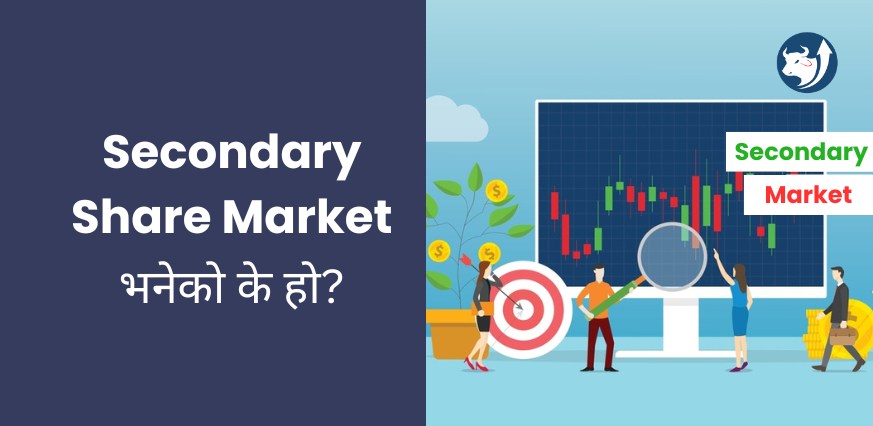The secondary market, often called the aftermarket, is a vital component of the financial ecosystem where investors buy and sell existing securities. Unlike the primary market, where securities are issued and sold for the first time, the secondary market allows the trading of already issued shares among investors.
As of January 2024, the market capitalization of NEPSE totaled Rs. 330,765.9 crores. About 23% of the total population of Nepal engages in the Stock market and the numbers keep growing.
The Secondary market is also known as NEPSE, Nepal Stock Exchange. It is the platform that allows you to buy or sell shares securely.
You may be interested in being a part of the 23% but may not know where to begin. This article can help you start your journey by telling you the basics of the secondary market.
What is the secondary market?
The secondary market serves as a platform where investors trade previously issued securities, such as stocks, bonds, and derivatives, without the involvement of the issuing companies. The shares bought in the primary market from the listed companies can be bought or sold here.
The prices of the shares differ from the original listed price. It depends on how the company is doing. If the company’s valuation has increased, it increases the cost per share, and similarly, if the company does not do well and its valuation has decreased, then the cost per share also decreases.
How can you enter the secondary market?
Apart from the basics that are required to be in the primary market like a bank account and opening a Demat account, you will also need the following additional accounts:
- Broker
- NEPSE TMS account
What is a broker account?
It is a standard practice that all the transactions done in the secondary market have to be done through a broker. You may wonder if you can buy or sell shares if you’ve already found a buyer or a seller. The answer is no. All of the buying and selling in NEPSE has to be done through a broker.
Brokers will receive a broker commission/fee which is a certain percentage of the amount transacted as a commission. You can create a broker account online or by visiting the broker’s office directly.
What is NEPSE TMS?
NEPSE TMS stands for Nepal Stock Exchange Trade Management System. After you have created your broker account, you can access NEPSE TMS. By filling in your username or client code and your password, you can trade in the secondary market from the comfort of your home.
The different brokers in the share market have their own unique TMS URLs. You can use it to come in contact with the broker you want.
To load money/collateral in the TMS account, you have to use connect IPS, Global IME, or Prabhu Bank digital wallet. Connect IPS links your bank account to your TMS account. These help you send a collateral amount to your TMS account. This allows you to buy and sell shares accordingly.
Functions of the Secondary Market
Providing Liquidity
One of the primary functions of the secondary market is to provide liquidity to investors by allowing them to buy and sell securities easily. Liquidity ensures that investors can convert their investments into cash quickly without notably affecting market prices.
Price Discovery
The secondary market facilitates price discovery by allowing investors to trade securities based on supply and demand dynamics. Through continuous trading activities, market prices are determined, reflecting the collective opinions and expectations of market participants.
Risk Management
Investors use the secondary market to manage their investment risks by diversifying their portfolios, hedging against price fluctuations, and adjusting their positions based on market conditions. The ability to trade securities freely provides investors with greater flexibility in managing their investment portfolios.
Challenges and Risks in the Secondary Market
Market Volatility
The secondary market is open to market volatility, characterized by rapid price fluctuations and unpredictable trading patterns. Volatility can be caused by various factors, including economic conditions, geopolitical events, and investor sentiment.
Insider Trading
Insider trading, where individuals trade securities based on non-public information, poses a significant risk to the integrity of the secondary market. Regulatory authorities enforce laws against insider trading to maintain market fairness and transparency.
Regulatory Changes
Changes in regulatory policies and market regulations can impact trading activities and investor behavior in the secondary market. Market participants need to stay informed about regulatory developments and adapt their strategies accordingly to mitigate regulatory risks.
The secondary market is where people earn a lot of profit. But it is also in the secondary market that people tend to lose money. It all depends on how good your research is and how alert you are to the happenings of the share market. Always remember, high risk equals high returns. It is a very lucrative market if you know where to invest and when to invest.
You may also like:
- What are the benefits of owning a share
- What are some common mistakes to avoid when trading stocks
- Basics to know before starting investment in Share Market
FAQs
What is TMS in stock trading?
TMS stands for Trading Management System. It allows the users to make transactions in the share market from their own homes. They can buy and sell shares from their own home.
What is the role of NEPSE in Nepal?
NEPSE shows the total market capitalization of companies’ transactions listed on the Nepal Stock Exchange.
Who owns NEPSE?
The government of Nepal owns NEPSE. The government owns 58.65% of the Nepal government.
How can I sell my stock in Nepal?
You can sell the stocks in Nepal in the secondary market by appointing a broker.
Who can invest in the share market?
Anyone with a trading account or an investment account can invest in the share market.

